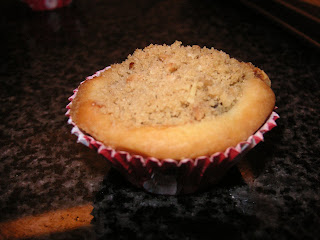This was always going to be a special challenge and the result was rather delicious! We had to make a Yule log using a Genoise sponge and covered in buttercream; the details of which are set out below. I chose to make my buttercream chocolate flavoured and it turned out to be a good decision!
Here’s the sponge all golden and springy from the oven:

As the buttercream is very light – almost a meringue/buttercream hybrid I decided to contrast this and fill my log with sweetened vanilla cream and chocolate sprinkles. I used a 300ml pot of double cream which I sweetened with approximately 4 tablespoons of icing sugar and a splash of vanilla extract. This was the point when I paused to ponder whether I had enough chocolate sprinkles. I think the fact that you can only just see the cream underneath meant that the answer was yes!

The trickiest bit was rolling the log. I found myself putting this off as I was fearful of the whole thing falling apart. It didn’t roll quite as tight as I hoped for but cracking was minimal so I count it as a success!


Here’s the log wrapped up tightly in greaseproof paper ready for the fridge overnight. I made the buttercream on the morning of the day it would be served:

The challenge rules demanded that we make mushrooms. I decided on making marzipan mushrooms and think I have given away that far too much of my youth was spent playing Mario games on my Nintendo console (I think it was a SNES which makes me sound really ancient). In my world this is what mushrooms look like (my brother ate one hoping it would give him a ‘power up’. Alas, it didn’t)

The buttercream is out-of-this-world delicious. Light and soft and smooth – everything you could want from a cake coating! Here is the finished log:



Of course, the proof of the log is in the eating and I can personally vouch for the deliciousness of this slice:

Plain Genoise:
3 large eggs
3 large egg yolks
pinch of salt
¾ cup (173g) of sugar
½ cup (115g) cake flour - spoon flour into dry-measure cup and level off (can also use plain flour minus 1 tablespoon)
¼ cup (58g) cornstarch
one 10 x 15 inch jelly-roll pan (swiss roll tin) that has been buttered and lined with parchment paper and then buttered again
How to make:
1.Set a rack in the middle of the oven and preheat to 400 degrees F/200°C/ fan oven 180°C/ GM 6.
2.Half-fill a medium saucepan with water and bring it to a boil over high heat. Lower the heat so the water is simmering.
3.Whisk the eggs, egg yolks, salt and sugar together in the bowl of a heavy-duty mixer. Place over the pan of simmering water and whisk gently until the mixture is just lukewarm, about 100 degrees if you have a thermometer (or test with your finger - it should be warm to the touch).
4.Attach the bowl to the mixer and, with the whisk attachment, whip on medium-high speed until the egg mixture is cooled (touch the outside of the bowl to tell) and tripled in volume. The egg foam will be thick and will form a slowly dissolving ribbon falling back onto the bowl of whipped eggs when the whisk is lifted.
5.While the eggs are whipping, stir together the flour and cornstarch.
6.Sift one-third of the flour mixture over the beaten eggs. Use a rubber spatula to fold in the flour mixture, making sure to scrape all the way to the bottom of the bowl on every pass through the batter to prevent the flour mixture from accumulating there and making lumps. Repeat with another third of the flour mixture and finally with the remainder.
7.Scrape the batter into the prepared pan and smooth the top.
8.Bake the genoise for about 10 to 12 minutes. Make sure the cake doesn’t overbake and become too dry or it will not roll properly.
9.While the cake is baking, begin making the buttercream.
10.Once the cake is done (a tester will come out clean and if you press the cake lightly it will spring back), remove it from the oven and let it cool on a rack.
Coffee Buttercream:
4 large egg whites
1 cup (230g) sugar
24 tablespoons (3 sticks or 1-1/2 cups i.e. 345g) unsalted butter, softened
2 tablespoons instant espresso powder
2 tablespoons rum or brandy
NB. I made a chocolate buttercream instead. This meant I omitted the coffee and rum and replaced by 200g melted chocolate – I used Green & Blacks milk chocolate and it was delicious!
How to make:
1.Whisk the egg whites and sugar together in the bowl of an electric mixer. Set the bowl over simmering water and whisk gently until the sugar is dissolved and the egg whites are hot. 2.Attach the bowl to the mixer and whip with the whisk on medium speed until cooled. Switch to the paddle and beat in the softened butter and continue beating until the buttercream is smooth. Dissolve the instant coffee in the liquor and beat into the buttercream.
Filling and frosting the log:
1.Run a sharp knife around the edges of the genoise to loosen it from the pan.
2.Turn the genoise layer over (unmolding it from the sheet pan onto a flat surface) and peel away the paper.
3.Carefully invert your genoise onto a fresh piece of parchment paper.
4.Spread with half the coffee buttercream (or whatever filling you’re using).
5.Use the parchment paper to help you roll the cake into a tight cylinder.
6.Transfer back to the baking sheet and refrigerate for several hours.
7.Unwrap the cake. Trim the ends on the diagonal, starting the cuts about 2 inches away from each end.
8.Position the larger cut piece on each log about 2/3 across the top.
9.Cover the log with the reserved buttercream, making sure to curve around the protruding stump.
10.Streak the buttercream with a fork or decorating comb to resemble bark.
11.Transfer the log to a platter and decorate with your mushrooms and whatever other decorations you’ve chosen.
Meringue Mushrooms:
3 large egg whites, at room temperature
¼ teaspoon cream of tartar
½ cup (115 g) granulated sugar
1/3 cup (75 g) icing sugar
Unsweetened cocoa powder for dusting
How to make:
1.Preheat the oven to 225 degrees F. Line 2 baking sheets with parchment. Have ready a pastry bag fitted with a small (no. 6) plain tip. In a bowl, using a mixer on medium-low speed, beat together the egg whites and cream of tartar until very foamy. Slowly add the granulated sugar while beating. Increase the speed to high and beat until soft peaks form when the beaters are lifted. Continue until the whites hold stiff, shiny peaks. Sift the icing sugar over the whites and, using a rubber spatula, fold in until well blended.
2.Scoop the mixture into the bag. On one baking sheet, pipe 48 stems, each ½ inch (12 mm.) wide at the base and tapering off to a point at the top, ¾ inch (2 cm.) tall, and spaced about ½ inch (12 mm.) apart. On the other sheet, pipe 48 mounds for the tops, each about 1-1/4 inches (3 cm.) wide and ¾ inch (2 cm.) high, also spaced ½ inch (12 mm.) apart. With a damp fingertip, gently smooth any pointy tips. Dust with cocoa. Reserve the remaining meringue.
3.Bake until dry and firm enough to lift off the paper, 50-55 minutes. Set the pans on the counter and turn the mounds flat side up. With the tip of a knife, carefully make a small hole in the flat side of each mound. Pipe small dabs of the remaining meringue into the holes and insert the stems tip first. Return to the oven until completely dry, about 15 minutes longer. Let cool completely on the sheets.
4.Garnish your Yule Log with the mushrooms.
Marzipan Mushrooms:
8 ounces (225g) almond paste
2 cups (460g) icing sugar
3 to 5 tablespoons light corn syrup/golden syrup
Cocoa powder
How to make:
1.To make the marzipan combine the almond paste and 1 cup of the icing sugar in the bowl of an electric mixer and beat with the paddle attachment on low speed until sugar is almost absorbed. 2.Add the remaining 1 cup of sugar and mix until the mixture resembles fine crumbs.
3.Add half the corn syrup, then continue mixing until a bit of the marzipan holds together when squeezed, adding additional corn syrup a little at a time, as necessary: the marzipan in the bowl will still appear crumbly.
4.Transfer the marzipan to a work surface and knead until smooth.
5.Roll one-third of the marzipan into a 6 inches long cylinder and cut into 1-inch lengths.
6.Roll half the lengths into balls. Press the remaining cylindrical lengths (stems) into the balls (caps) to make mushrooms.
7.Smudge with cocoa powder.









.JPG)
.JPG)
 Assembling the panels is the tricky bit. Don’t be afraid to use mugs or pots to rest the panels against whilst the icing is drying:
Assembling the panels is the tricky bit. Don’t be afraid to use mugs or pots to rest the panels against whilst the icing is drying:.JPG)
.JPG) I’m not sure you’d get a clean survey on this house – the chimney looks a bit wonky!
I’m not sure you’d get a clean survey on this house – the chimney looks a bit wonky!.JPG)
.JPG)
 Unfortunately, he then claimed squatters’ rights!
Unfortunately, he then claimed squatters’ rights!




 If it’s possible for baked items to be cute then these are the cutest little things around! I like cakes or tarts that do more than one thing – these are great because you have the pastry case which houses the mincemeat and then top it off with nutty crumble. Is it a cake or a dessert? Should you have it with a cup of tea or after dinner? Any answer is correct.
If it’s possible for baked items to be cute then these are the cutest little things around! I like cakes or tarts that do more than one thing – these are great because you have the pastry case which houses the mincemeat and then top it off with nutty crumble. Is it a cake or a dessert? Should you have it with a cup of tea or after dinner? Any answer is correct. They look so cute en masse:
They look so cute en masse:




































